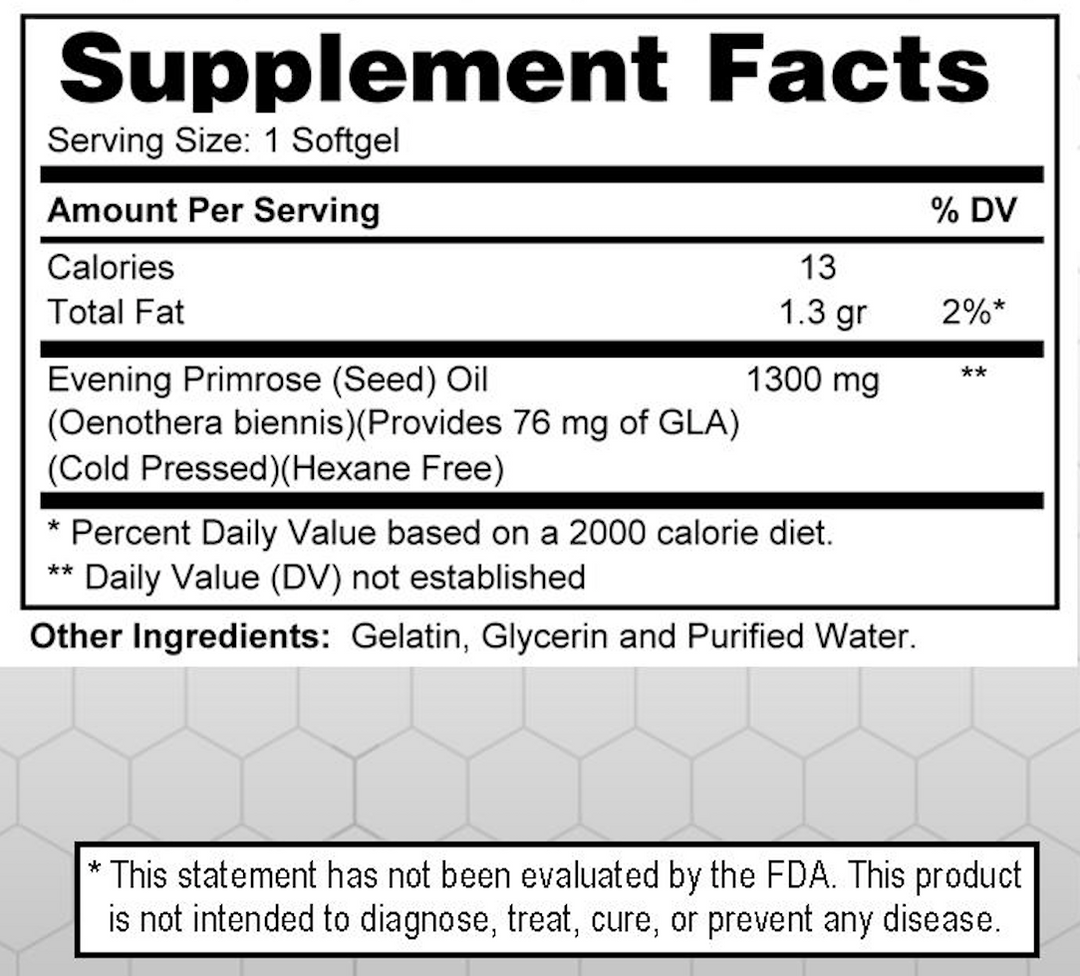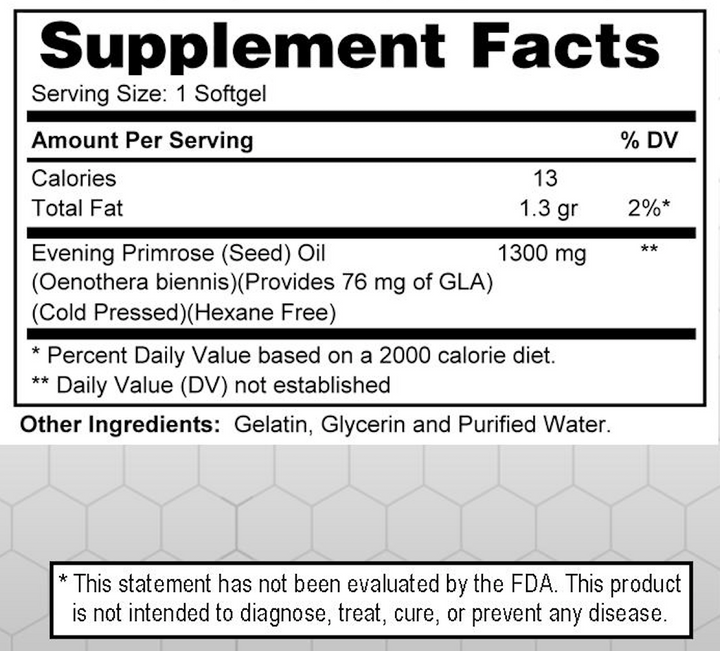Evening primrose oil has been used since the 1930s for supporting healthy skin, healthy joints, and healthy hormone balance in women. Supports normal, healthy, and pain-free menstrual cycles and normal moods through the premenstrual time. Also supports healthy, symptom-free menopause.
Supports healthy skin, especially in those who are prone to skin inflammation. ‡
Manufactured in a US FDA inspected facility. GMP Compliant. Purity and Potency Guaranteed! We use the highest quality raw materials available. Testing is done at various stages of production. All IOH Nutrition Formulas Meet or Exceed cGMP Quality Standards.
Evening primrose oil (EPO) is made from the evening primrose plant, a source of essential fatty acids such as gamma linolenic acid (GLA), linolenic acid, and vitamin E.
Our bodies need a healthy balance of essential fatty acids, such as those found in evening primrose oil.
1. Promotes Skin Health: Evening primrose oil has proven to be valuable as a supportive treatment for people suffering from skin conditions, such as eczema, psoriasis and atopic dermatitis.
Studies have shown that evening primrose oil can help with functional skin issues, such as redness, firmness and roughness. There is evidence that people with eczema often have limited ability to process fatty acids. This results in a deficiency of GLA. GLA is a fatty acid that the body can convert to substances that reduce inflammation and cell growth.
2. Supports Healthy Menstrual Cycles: EPO may be helpful during a woman’s premenstrual time as well as during the period to help with occasional symptoms of breast tenderness, bloating, water retention, acne, depression, irritability, foggy thinking and headaches.
3. Promotes Joint Health: EPO as a source of GLA supports healthy cytokine activity, and promotes healthy prostaglandin E1 (PGE1) production. This mechanism may help to support joint health and offer some relief.
4. Support Cardiovascular Health: Studies have shown that Evening Primrose Oil supports healthy lipid metabolism and may provide oxidative protection by promoting glutathione reductase and transferase activities. This alone significantly promotes healthy cardiovascular function especially in women.
*These statements have not been evaluated by the FDA. This product is not intended to diagnose, treat, cure, or prevent any disease.
Dosage: Take 1-4 softgels per day, in divided doses, with meals.
90 Softgels
References
1. Koo, J. H., Lee, I., Yun, S. K., Kim, H. U., Park, B. H., and Park, J. W. Saponified evening primrose oil reduces melanogenesis in B16 melanoma cells and reduces UV-induced skin pigmentation in humans. Lipids 2010;45(5):401-407.
2. Wang, W. Liu P. J. Evening Primrose Oil or other essential fatty acids for the treatment of pre-menstrual syndrome (PMS). Cochrane Database Sys Rev 2010 2010;11:CD001123.
3. Sharif, SeyedehNazanin, and FatemehDarsareh. "Impact of Evening Primrose Oil Consumption On Psychological Symptoms of Postmenopausal Women: a Randomized Double-blinded Placebo-controlled Clinical Trial." Menopause (New York, N.Y.), 2019.
4. Cameron M, Gagnier JJ, Chrubasik S. Herbal therapy for treating rheumatoid arthritis. Cochrane Database of Systematic Reviews 2011, Issue 2. Art. No.: CD002948. DOI: 10.1002/14651858.CD002948.pub2.
5. Kwon, H S., et al. "Topical Evening Primrose Oil as a Possible Therapeutic Alternative in Children WithMolluscumContagiosum." Clinical and Experimental Dermatology, vol. 42, no. 8, 2017, pp. 923-925.
6. Yakoot, M., Salem, A., and Omar, A. M. Effectiveness of a herbal formula in women with menopausal syndrome. Forsch.Komplementmed. 2011;18(5):264-268
7. Pruthi, S., Wahner-Roedler, D. L., Torkelson, C. J., Cha, S. S., Thicke, L. S., Hazelton, J. H., and Bauer, B. A. Vitamin E and evening primrose oil for management of cyclical mastalgia: a randomized pilot study. Altern.Med Rev. 2010;15(1):59- 67.
8. Mahboubi M. (2019). Evening Primrose (Oenotherabiennis) Oil in Management of Female Ailments. Journal of menopausal medicine, 25(2), 74–82. doi:10.6118/jmm.18190
9. Chung, Bo Young, et al. "Effect of Evening Primrose Oil On Korean Patients With Mild Atopic Dermatitis: a Randomized, Double-Blinded, Placebo-Controlled Clinical Study." Annals of Dermatology, vol. 30, no. 4, 2018, pp. 409-416.
10. Evening Primrose.Drugs and Lactation Database (LactMed). National Library of Medicine (US), 2006, Bethesda (MD).
11. Nasri, K., Akrami, S., Rahimi, M., Taghizadeh, M., Behfar, M., Mazandaranian, M. R., ...Asemi, Z. (2018). The effects of vitamin D and evening primrose oil co-supplementation on lipid profiles and biomarkers of oxidative stress in vitamin Ddeficient women with polycystic ovary syndrome: A randomized, double-blind, placebo-controlled trial. Endocrine Research, 43(1), pp. 1-10. doi:10.1080/07435800.2017.1346661.
12. Majdinasab, Nastaran, et al. "The Effect of Evening Primrose Oil On Fatigue and Quality of Life in Patients With Multiple Sclerosis." Neuropsychiatric Disease and Treatment, vol. 14, 2018, pp. 1505-1512.
13. Jamilian, M., Karamali, M., Taghizadeh, M., Sharifi, N., Jafari, Z., Memarzadeh, M. R., ...Asemi, Z. (2016). Erratum to: Vitamin D and Evening Primrose Oil Administration Improve Glycemia and Lipid Profiles in Women with Gestational Diabetes. Lipids, 51(3), p. 357. doi:10.1007/s11745-016-4138-9.
14. Mosaad, S. M., Zaitone, S. A., Ahmed, A. A., Abo-Elmatty, D. M., El-Baz, A. A., &Moustafa, Y. M. (2017). Evening primrose oil or forskolin ameliorates celecoxib-enhanced upregulation of tissue factor expression in mice subjected to lipopolysaccharide-induced endotoxemia. Naunyn-Schmiedeberg's Archives of Pharmacology, 390(5), pp. 483-492. doi:10.1007/s00210-017-1342-y.
15. Abo-Gresha, N. M., Abel-Aziz, E. Z., &Greish, S. M. (2014). Evening primrose oil ameliorates platelet aggregation and improves cardiac recovery in myocardial-infarct hypercholesterolemic rats. International journal of physiology, pathophysiology and pharmacology, 6(1), 23–36.



















